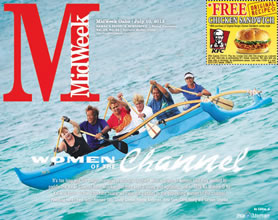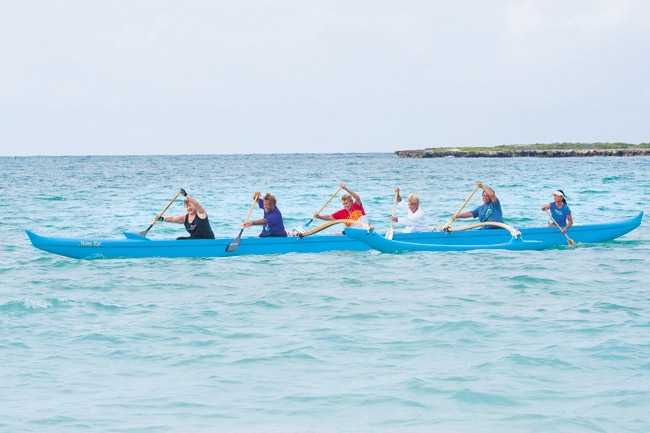Women Of The Channel
It’s too long and too rough, the guys practically laughed, when a group of women said they wanted to paddle the Kaiwi Channel from Molokai. But they kept training, and in 1979 Na Wahine O Ke Kai was born. As the 35th race nears, we salute the pioneering women of the channel
American opera singer Beverly Sills once said, “You might be disappointed if you fail, but you are doomed if you don’t try.”
mw-cover-womenpaddlers-2
For more than 20 years, women paddlers not only were told they could not successfully cross the Kaiwi Channel, they were even told, “It’s too dangerous to try.”
Sitting idle was never an option
The dream for a women’s race started two years after the first men’s Molokai to Oahu race in 1954. A veteran women’s crew from Waikiki Surf Club asked coaches and race officials to consider a similar event for women. Critics insisted women couldn’t handle the treacherous and unpredictable Kaiwi Channel.
They were wrong. “When the subject of doing Molokai came up, the men told us it couldn’t be done,” says veteran paddler Carleen Ornellas. “We knew we could do this!”
It would take 21 years before someone would listen
Ornellas and Donna Coelho-Woffe were pioneers who believed. Both women paddled for Kailua Canoe Club and approached Leinani Faria with the grand idea. The women wanted to race from Molokai to Oahu and prove that the channel was not reserved for men.
“She listened and was committed to help us because she believed, too,” says Ornellas.
But despite their drive and will to succeed, the women knew they would need the support of men.
Support, not approval
“We knew we needed to find guys who were willing to take us across the channel,” says veteran paddler Rosie Lum. “Someone who was willing to take a chance and somebody who believed we were ready.”
Two crews believed they were ready. One group, spearheaded by Coelho-Woffe, was made up of women from Kailua, Outrigger and Lanikai canoe clubs and Waikiki Surf Club. They named themselves “Onipaa.” The other crew was from Healani Canoe Club, coached by Babe Bell.
It took years of patience and persistence to convince everyone that it was possible for women to paddle across the Kaiwi Channel. In October 1975, 36 women made the first unofficial crossing.
“We trained like crazy and it was awesome,” says Lum. “Healani beat our tails that day, but when we got to the finish line at the Ilikai Hotel, we knew we had accomplished something very special.”
The women proved to the world – and to the men – that they could paddle 41 miles.
Faria and Hannie Anderson officiated the first crossing.
“The girls in ’75 proved that it was possible,” says Anderson. “We set a goal and achieved it. It is still one of the most gratifying days of my life.”
Faria tragically passed away from cancer, but before she died, Ornellas says she told the women, “Keep going, keep doing this, you women can do this.”
Hannie Anderson took the reins that day and never stopped believing
Four years later, the women would organize to do it again, but this time as a sanctioned event. In February 1979, race director Anderson founded Na Wahine o Ke Kai Association with support from committee members Shelly Gilman, Haunani Campos-Olds, Sig Tannehill, Carol Young, Ornellas and Lum. Puna Dawson christened the event Na Wahine o Ke Kai, or “Women of the Sea.”
“Hannie was focused on making this happen,” says Lum. “She was the mover and shaker in fulfilling our dreams.”
It was a dream shared by many women, and Oct. 15, 1979, it became a reality. Sixteen crews left Hale o Lono bound for Oahu. Outrigger Canoe Club finished in six hours, 35 minutes, 14 seconds in its first official women’s Molokai-to-Oahu canoe race.
“In 1979 there were still doubters, but we jumped for joy that we had 16 crews,” says Anderson, who has never raced across the channel. “In order for me to compete in the race, I would have had to train. Instead, I took the bull by the horns and served as race director. Organizing the first official race was a rewarding feeling. I have no regrets.”
But after making history in 1979, the race was cancelled the following year because of 30-foot surf and strong winds. Anderson remembers the weekend well.
“The day before the race, the Coast Guard advised us to cancel,” she recalls. “The next morning they called and asked, ‘Have you decided what you’re going to do because it’s blowing hard in the channel.'”
Anderson drove down to Hale o Lono Harbor and made the decision not to let the wahine go.
“I stood in front of 18 crews and told them the race was cancelled,” says Anderson. “A few of them thought they could make it and they weren’t happy. In fact, some of them were very upset. And there were others who were happy because they were scared.”
“Several crews wanted to go, but I was very happy not to go,” recalls Ornellas. “I know my limitations and I respect that ocean.”
Race officials helped organize return flights back to Oahu for the paddlers. On Anderson’s flight back, Hawaiian Airlines pilot John Carroll flew officials over the channel and pointed to the mammoth ocean swells.
“John wanted to show us how big the waves were, and then he said, Hannie, you made the right call, ” says Anderson. “The waves were 30-35 feet. We were very fortunate.”
Although 1980 was the only time the race has been cancelled, in 2012 Anderson and her race committee were faced with a similar decision. But this time waves in the channel weren’t the issue – the problem was at Hale o Lono Harbor.







